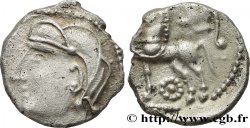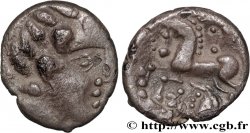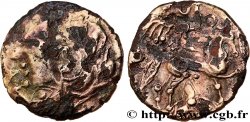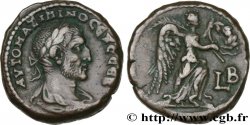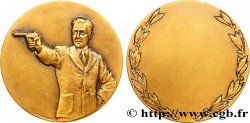bga_530299 - GALLIA - LEMOVICES (Región de Limoges) Statère à la grue, en argent / billon
No disponible.
Artículo vendido en nuestra tienda (2021)
Precio : 1 125.00 €
Artículo vendido en nuestra tienda (2021)
Precio : 1 125.00 €
Tipo : Statère à la grue, en argent / billon
Fecha: c. 100-50 BC.
Nombre del taller / ciudad: Limoges (87)
Metal: plata
Diámetro: 16,5 mm
Eje de acuñación: 12 h.
Peso: 4,91 g.
Grado de rareza: INÉDIT
Comentarios sobre el estado de conservación:
Très bel exemplaire avec un joli revers complet et bien centré. Manque de métal au droit à 12h. Patine de collection ancienne
N° en los catálogos de referencia :
Anverso
Titulatura del anverso: ANÉPIGRAPHE.
Descripción del anverso: Tête à droite, la chevelure en grosses mèches aquitaniques, l’oreille marquée.
Reverso
Titulatura del reverso: ANÉPIGRAPHE.
Descripción del reverso: Cheval à droite, une grue posée sur la croupe entre deux annelets pointés ; un trèfle entre les jambes.
Comentario
Avec un flan de 5 mm d’épaisseur et un métal très fortement chargé en argent, cette monnaie se distingue des frappes en or et en bronze ; si le style de flan correspond aux monnaies en bronze, cet exemplaire en billon ou en argent semble être sans équivalent et manquer aux ouvrages de références !
Le motif d‘accolade partant de la bouche (hors flan sur cet exemplaire) devant le visage, est parfois interprété comme le signe de la parole ; on retrouve ce détail sur les statères des Bituriges, mais aussi sous forme des deux dauphins, plus ou moins stylisés, sur la plupart des monnaies d’argent du sud, dites “à la croix”.
With a 5 mm thick flan and a metal heavily loaded with silver, this coin stands out from the gold and bronze strikes; if the flan style corresponds to the bronze coins, this example in billon or silver seems to be without equivalent and missing from reference works! The brace motif starting from the mouth (off flan on this example) in front of the face, is sometimes interpreted as the sign of speech; we find this detail on the staters of the Bituriges, but also in the form of the two dolphins, more or less stylized, on most of the silver coins of the south, called “with the cross”
Le motif d‘accolade partant de la bouche (hors flan sur cet exemplaire) devant le visage, est parfois interprété comme le signe de la parole ; on retrouve ce détail sur les statères des Bituriges, mais aussi sous forme des deux dauphins, plus ou moins stylisés, sur la plupart des monnaies d’argent du sud, dites “à la croix”.
With a 5 mm thick flan and a metal heavily loaded with silver, this coin stands out from the gold and bronze strikes; if the flan style corresponds to the bronze coins, this example in billon or silver seems to be without equivalent and missing from reference works! The brace motif starting from the mouth (off flan on this example) in front of the face, is sometimes interpreted as the sign of speech; we find this detail on the staters of the Bituriges, but also in the form of the two dolphins, more or less stylized, on most of the silver coins of the south, called “with the cross”








 Informar de un error
Informar de un error Imprimir la página
Imprimir la página Comparte mi selección
Comparte mi selección Haz una pregunta
Haz una pregunta Consignar / vender
Consignar / vender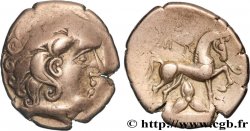
 Descriptivo
Descriptivo